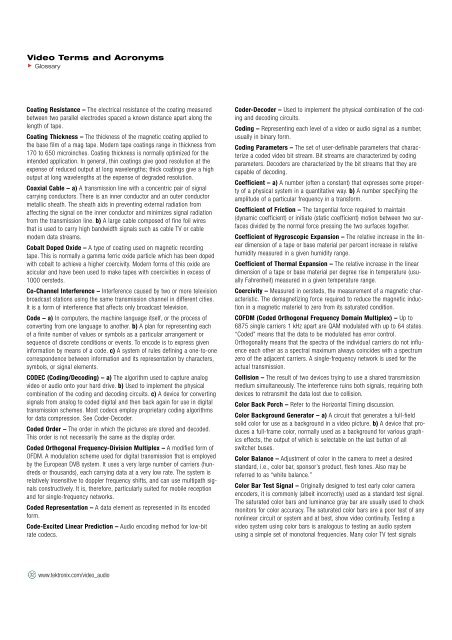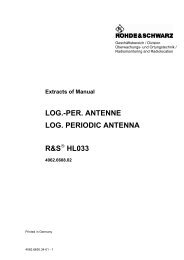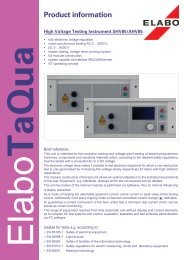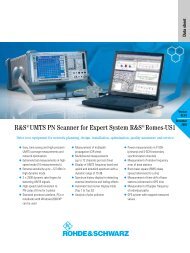Glossary of Video Terms and Acronyms - Isotest
Glossary of Video Terms and Acronyms - Isotest
Glossary of Video Terms and Acronyms - Isotest
Create successful ePaper yourself
Turn your PDF publications into a flip-book with our unique Google optimized e-Paper software.
<strong>Video</strong> <strong>Terms</strong> <strong>and</strong> <strong>Acronyms</strong><br />
<strong>Glossary</strong><br />
Coating Resistance – The electrical resistance <strong>of</strong> the coating measured<br />
between two parallel electrodes spaced a known distance apart along the<br />
length <strong>of</strong> tape.<br />
Coating Thickness – The thickness <strong>of</strong> the magnetic coating applied to<br />
the base film <strong>of</strong> a mag tape. Modern tape coatings range in thickness from<br />
170 to 650 microinches. Coating thickness is normally optimized for the<br />
intended application. In general, thin coatings give good resolution at the<br />
expense <strong>of</strong> reduced output at long wavelengths; thick coatings give a high<br />
output at long wavelengths at the expense <strong>of</strong> degraded resolution.<br />
Coaxial Cable – a) A transmission line with a concentric pair <strong>of</strong> signal<br />
carrying conductors. There is an inner conductor <strong>and</strong> an outer conductor<br />
metallic sheath. The sheath aids in preventing external radiation from<br />
affecting the signal on the inner conductor <strong>and</strong> minimizes signal radiation<br />
from the transmission line. b) A large cable composed <strong>of</strong> fine foil wires<br />
that is used to carry high b<strong>and</strong>width signals such as cable TV or cable<br />
modem data streams.<br />
Cobalt Doped Oxide – A type <strong>of</strong> coating used on magnetic recording<br />
tape. This is normally a gamma ferric oxide particle which has been doped<br />
with cobalt to achieve a higher coercivity. Modern forms <strong>of</strong> this oxide are<br />
acicular <strong>and</strong> have been used to make tapes with coercivities in excess <strong>of</strong><br />
1000 oersteds.<br />
Co-Channel Interference – Interference caused by two or more television<br />
broadcast stations using the same transmission channel in different cities.<br />
It is a form <strong>of</strong> interference that affects only broadcast television.<br />
Code – a) In computers, the machine language itself, or the process <strong>of</strong><br />
converting from one language to another. b) A plan for representing each<br />
<strong>of</strong> a finite number <strong>of</strong> values or symbols as a particular arrangement or<br />
sequence <strong>of</strong> discrete conditions or events. To encode is to express given<br />
information by means <strong>of</strong> a code. c) A system <strong>of</strong> rules defining a one-to-one<br />
correspondence between information <strong>and</strong> its representation by characters,<br />
symbols, or signal elements.<br />
CODEC (Coding/Decoding) – a) The algorithm used to capture analog<br />
video or audio onto your hard drive. b) Used to implement the physical<br />
combination <strong>of</strong> the coding <strong>and</strong> decoding circuits. c) A device for converting<br />
signals from analog to coded digital <strong>and</strong> then back again for use in digital<br />
transmission schemes. Most codecs employ proprietary coding algorithms<br />
for data compression. See Coder-Decoder.<br />
Coded Order – The order in which the pictures are stored <strong>and</strong> decoded.<br />
This order is not necessarily the same as the display order.<br />
Coded Orthogonal Frequency-Division Multiplex – A modified form <strong>of</strong><br />
OFDM. A modulation scheme used for digital transmission that is employed<br />
by the European DVB system. It uses a very large number <strong>of</strong> carriers (hundreds<br />
or thous<strong>and</strong>s), each carrying data at a very low rate. The system is<br />
relatively insensitive to doppler frequency shifts, <strong>and</strong> can use multipath signals<br />
constructively. It is, therefore, particularly suited for mobile reception<br />
<strong>and</strong> for single-frequency networks.<br />
Coded Representation – A data element as represented in its encoded<br />
form.<br />
Code-Excited Linear Prediction – Audio encoding method for low-bit<br />
rate codecs.<br />
32 www.tektronix.com/video_audio<br />
Coder-Decoder – Used to implement the physical combination <strong>of</strong> the coding<br />
<strong>and</strong> decoding circuits.<br />
Coding – Representing each level <strong>of</strong> a video or audio signal as a number,<br />
usually in binary form.<br />
Coding Parameters – The set <strong>of</strong> user-definable parameters that characterize<br />
a coded video bit stream. Bit streams are characterized by coding<br />
parameters. Decoders are characterized by the bit streams that they are<br />
capable <strong>of</strong> decoding.<br />
Coefficient – a) A number (<strong>of</strong>ten a constant) that expresses some property<br />
<strong>of</strong> a physical system in a quantitative way. b) A number specifying the<br />
amplitude <strong>of</strong> a particular frequency in a transform.<br />
Coefficient <strong>of</strong> Friction – The tangential force required to maintain<br />
(dynamic coefficient) or initiate (static coefficient) motion between two surfaces<br />
divided by the normal force pressing the two surfaces together.<br />
Coefficient <strong>of</strong> Hygroscopic Expansion – The relative increase in the linear<br />
dimension <strong>of</strong> a tape or base material per percent increase in relative<br />
humidity measured in a given humidity range.<br />
Coefficient <strong>of</strong> Thermal Expansion – The relative increase in the linear<br />
dimension <strong>of</strong> a tape or base material per degree rise in temperature (usually<br />
Fahrenheit) measured in a given temperature range.<br />
Coercivity – Measured in oersteds, the measurement <strong>of</strong> a magnetic characteristic.<br />
The demagnetizing force required to reduce the magnetic induction<br />
in a magnetic materiel to zero from its saturated condition.<br />
COFDM (Coded Orthogonal Frequency Domain Multiplex) – Up to<br />
6875 single carriers 1 kHz apart are QAM modulated with up to 64 states.<br />
“Coded” means that the data to be modulated has error control.<br />
Orthogonality means that the spectra <strong>of</strong> the individual carriers do not influence<br />
each other as a spectral maximum always coincides with a spectrum<br />
zero <strong>of</strong> the adjacent carriers. A single-frequency network is used for the<br />
actual transmission.<br />
Collision – The result <strong>of</strong> two devices trying to use a shared transmission<br />
medium simultaneously. The interference ruins both signals, requiring both<br />
devices to retransmit the data lost due to collision.<br />
Color Back Porch – Refer to the Horizontal Timing discussion.<br />
Color Background Generator – a) A circuit that generates a full-field<br />
solid color for use as a background in a video picture. b) A device that produces<br />
a full-frame color, normally used as a background for various graphics<br />
effects, the output <strong>of</strong> which is selectable on the last button <strong>of</strong> all<br />
switcher buses.<br />
Color Balance – Adjustment <strong>of</strong> color in the camera to meet a desired<br />
st<strong>and</strong>ard, i.e., color bar, sponsor’s product, flesh tones. Also may be<br />
referred to as “white balance.”<br />
Color Bar Test Signal – Originally designed to test early color camera<br />
encoders, it is commonly (albeit incorrectly) used as a st<strong>and</strong>ard test signal.<br />
The saturated color bars <strong>and</strong> luminance gray bar are usually used to check<br />
monitors for color accuracy. The saturated color bars are a poor test <strong>of</strong> any<br />
nonlinear circuit or system <strong>and</strong> at best, show video continuity. Testing a<br />
video system using color bars is analogous to testing an audio system<br />
using a simple set <strong>of</strong> monotonal frequencies. Many color TV test signals





